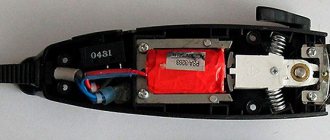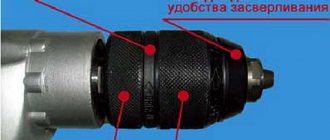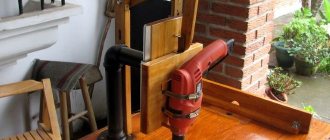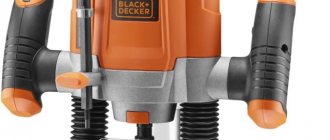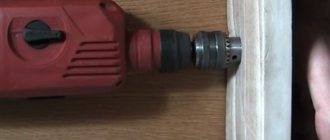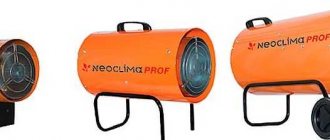Good day! In this article, I will tell you how to choose a drill for certain needs so that it confidently copes with the work for which you want to use it. The answer to the question of which drill to buy will depend on whether you want to buy it for home or for work, whether you need it electric (mains) or battery-powered, impact or non-impact, as well as some other factors. After reading the article to the end, you will become well versed in this topic, thanks to which you will be able to choose the best and most reliable drill for yourself, so that it is of high quality, but at the same time you do not overpay for it. So let's get started.
What is a drill
A drill is a hand-held machine for drilling in various materials (wood, metals, plastics, as well as brick and concrete).
The first electric drills appeared at the end of the 19th century after the creation of electric motors. They naturally looked different than in our time, they were bulky, and they had to be held with both hands when working.
Drills with "pistol" handles were invented in the early 20th century.
It is called a manual machine because it needs to be held in your hands when working. But based on the type of drive, drills are called electric, pneumatic, and again manual (mechanical).
Electric drills are driven by a built-in electric motor, pneumatic ones are driven by compressed air, and hand drills are driven, of course, by hand.
We will only consider modern electric drills.
An electric drill is the most popular power tool that most owners purchase first for their household.
This tool is necessary both in a city apartment for new residents, when renovating an apartment, and in the country.
Hanging a cornice on windows, a dish dryer in the kitchen, various shelves in the bathroom, drilling holes in a concrete wall or wooden board and many other jobs where you can’t do without a drill.
What parameters should you use to choose a device?
When choosing a drill, you need to pay attention not only to its cost, size or functionality. Different manufacturers produce entire lines of drills that differ from each other only in power or number of speeds - and these are also important parameters
Let's talk about them in more detail.
Power
The ability to drill materials of different hardness and rotation speed depend specifically on the power of the tool - it can reach 2000 W. The higher this indicator, the faster the drill will cope with any, even reliable, overlap. You can press the handle without any fear, because the powerful device will not jam.
Powerful drills can be quite compact
Criteria for choosing a drill by power level:
- for minor repairs in an apartment, you can purchase a 450 W device;
- for craftsmen who carry out repairs at emergency sites, a 700 W device is sufficient;
- experienced builders use 900-1000 W equipment;
- metalworking enterprises use devices with a power of more than 1200 W.
To work with hard materials you will need a powerful drill
Number of speeds
When performing the same type of work frequently, it is necessary to have a drill with a set speed, because certain material at this value will remain intact, while others, on the contrary, may be destroyed.
Thus, some models of drills operate only at one speed, which can be adjusted by the number of revolutions. However, in order to constantly change these settings, it will take time, and sometimes the master needs to start working with metal immediately after wood.
Model that allows you to adjust the speed using a switch
For such cases, drill models have been developed that already have several basic speeds. During work, the master will be able to quickly switch them, setting the required speed.
For example, models with two speeds will be appreciated by people who have to constantly work with two materials of different hardness (metal, wood). Four-speed devices will be required by craftsmen who have to work with metal, wood, plastic, and stone. In order to start drilling new material, you only need to attach another drill or attachment.
Using a drill you can not only make holes, but also polish surfaces
Cable
All mains powered models cannot travel further than the cable. It, in turn, can have a length from 150 to 400 centimeters.
So, if the structure is assembled in one place, then too long a cable will not be required. While car service workers use devices whose wire length reaches 250 centimeters. Cables of maximum length are also relevant for construction sites.
Household drills usually have a minimum cable length
Case
Some instruments are sold in cardboard boxes, while others are sold in plastic cases. The advantage of the second option is that such cases have convenient compartments for storing components, so usually drill models packed in cases have a higher cost.
Having a case will be a clear advantage
Electric drill device
An electric drill consists of an electric motor, gearbox, chuck, housing, power cord with plug and controls.
The electric motor is the heart of the drill; it rotates the drill when drilling holes.
A gearbox is a device consisting of gears that reduces the motor's own high rotation speed to the normal rotation speed of the drill, which is necessary for the correct drilling mode.
By reducing the rotation speed, the drill torque increases, that is, the drilling power.
Chuck - a chuck is attached to the output shaft of the gearbox, intended for securing a working tool - a drill.
There are two types of chucks based on the method of securing the working tool: “with a key” and quick-clamping.
To securely secure the drill in the first chuck, a separate key is required, which must be at hand at all times (which is not very convenient).
Keyless chucks do not require a key. The drill is secured in such a chuck “by hand”.
Chucks with a key allow you to more securely secure the drill in the chuck, which prevents it from turning, while quick-release chucks are more convenient and there is no risk of losing the key.
The body of modern household drills is made of durable plastic. Serves for placement inside the motor and gearbox housing, provides the necessary electrical protection for the user, as well as for fastening controls and the electrical cord. The body of professional drills can also be metal.
Controls – used to control the electric drill. These include:
- switch (“trigger”);
- engine speed controller;
- motor rotation direction switch;
- switch for the hammer drilling function.
Power cord - used to connect the drill to the electrical network. The cord must be durable, with reliable electrical insulation.
For ease of use, many drills are equipped with an additional removable side handle and a plastic or metal depth gauge.
Here we are looking at hammerless drills . Recently, so-called impact drills .
Impact drills have an additional function - “impact drilling”. With this kind of drilling, in addition to the rotational movement, the drill also has a reciprocating movement with a high frequency (for example, 45,000 blows per minute).
“Punch drilling” is used to drill holes in brick and concrete walls and allows you to do this work more efficiently, saving time and effort.
In addition to performing the main function - drilling, a drill can be used to perform several additional operations, for example, grinding, polishing, drilling large holes, stirring paint materials, cleaning the surface and removing old paint.
To perform these operations and some others, it is necessary to purchase or make appropriate drill attachments. These attachments have a shank similar to the shank of a drill, which secures the attachments to the drill chuck.
What types of cartridges are there?
The basis of the drill design is the chuck - it holds the drill and does not allow it to fall deep and spin in vain. There are several main types of cartridges; they differ in the method of fixation.
Table 3. Types of cartridges that differ in design features
| Type, illustration | Description |
| Key | This is a clamping device that moves at points due to the movement of the key along the teeth on the chuck. This chuck allows you to better secure the drill, but the master will constantly need to use the key, so it is usually attached to the drill wire - this way it will be visible at any time. Such a device is best suited for work where drills do not have to be constantly changed. |
| Quick-release | It has the same principle of operation as any button, due to which the drill is fixed. In this case, you do not have to use a special wrench; you can start working immediately after changing the drill. This way, the master will be able to work quickly and, if necessary, use different drills. This option is best suited for professional builders who have to work with a large number of materials of different thicknesses throughout the day. |
| Collet | In this case, the drill is fixed after clamping the washer. Of course, a key is not required here either, but still the master has to put in more effort. This chuck is recommended for car repair technicians or other specialists who only have to replace drill bits from time to time. |
Built-in backlight
Some drill models have additional LED lighting. Thus, the master can clearly see the work area even in low light in the room.
This function is especially useful during the installation of plumbing fixtures, because it is in rooms of this type that most often there is not enough light.
LED lights
Drilling diameter
Any chuck will be able to fix a drill of the minimum size, but the maximum value varies for all products
That is why, before purchasing a particular drill model, it is important for the master to make sure that the tool can drill a hole of the required diameter
There are drills with different drilling diameters
Main features of drills of different diameters:
- For a brick wall, it will be optimal to use drills from 9 to 80 millimeters.
- for plumbing installation, drills of about 9-32 millimeters will be required;
- when working with metal structures, use drills up to 32 millimeters;
- When drilling wood with drills, prepare holes from 10 to 70 millimeters.
Technical characteristics of electric drills
Let's consider the average ranges of technical characteristics of various models of electric drills.
We are considering the range in relation to use in the country and at home (without miniature and powerful professional devices).
The main technical characteristics are as follows:
- supply voltage (V) – 230;
- power consumption (W) – 500 – 1200;
- speed (rpm) max. – 2700-3600;
- drilling diameter (mm) max. – metal – 8 – 22;
- wood – 20 – 50;
- concrete - no, 13-35;
- chuck inner diameter (mm) – 0.8-10; 1.5-10; 1.5-13; 16max;
- network cable length (m) – 1.9-2.0;
- weight (kg) – 1.2 – 3.8;
- number of speeds – 1; 2;
- speed control – yes;
- reverse – yes; No;
- cartridge type – key; quick-release;
- speed limiter – yes; No.
Which household drills are suitable for ladies?
Husbands may argue that for lovely ladies, even during the period of apartment renovation, there will always be something to do without this tool. However, representatives of the fair sex who have embarked on the difficult path of “apprenticeship” and decided to choose a drill for themselves also deserve respect. Therefore, let’s put aside jokes like “do you want a pink drill or one with rhinestones?” and we’ll tell you what a girl should pay attention to when choosing this instrument.
The most important criteria for ladies are lightness and convenience. That's why some experts in the field of household tools strongly recommend that girls stick with a screwdriver and not apply for a drill. One way or another, it should be understood that a light weight model will most likely lose in power. On the other hand, women are also different, and many of them are endowed with excellent physical shape and stamina. In this case, it is worth choosing the optimal weight/power ratio based on the principle of “how much you can withstand.”
The fair half of society also has different goals regarding a drill: to hang a shelf that has been an eyesore in the corner for six months, to hang pictures from one wall to another, to repair furniture, etc. Experienced repairmen and repairwomen advise choosing something from popular brands, and preferably with a hammer drill function.
To the objection that a hammer drill with an impact action will destroy the furniture during repairs even more due to drilling with impact, professionals respond that this function can be easily turned off. All that remains is to test this in practice. Let's consider the most popular drill models today, which, according to their technical characteristics, are perfect, including for the fair sex.
Safety precautions when operating electric drills
Safety precautions when operating an electric drill are of no small importance, since it is connected to the mains and has a rotating chuck with a tool fixed in it.
In this case, both electrical and mechanical hazards are present.
To prevent injury, the following basic rules must be observed when using an electric drill:
- Before starting work, carefully read the operating instructions (manual), paying special attention to safety requirements;
- Before turning on, check the consistency of the power supply voltage of the tool and the electrical network;
- check the integrity of the insulation of the power cord (cable), plug and socket;
- during operation, protect the cord from damage, do not carry the drill by the cord, do not remove the plug from the socket by pulling the cord;
- Do not use the drill in explosive areas containing flammable liquids, gases or explosive dust. When operating a drill, sparks are generated that can cause a fire or explosion;
- do not use the tool in a state of severe fatigue, illness, under the influence of medications that affect vision and reaction, or while under the influence of alcohol or drugs;
- Do not allow children or people who have no experience in using the drill and have not studied the safety rules for operating the drill to use the drill;
- To avoid breaking the drill or jamming, do not use excessive force when drilling, especially with small-diameter drills;
- Do not allow rain or snow to come into contact with the power tool; a short circuit or damage to the insulating properties may occur;
- When drilling, wear safety glasses, and when performing work that generates dust, wear a respirator; Wear suitable clothing, shoes and gloves. Long hair, parts of clothing and gloves should be kept out of the area of the rotating chuck and drill;
- do not allow children and unauthorized persons to be in the work area;
- when replacing the drill, when finishing work, remove the plug from the power socket and set the on/off key to the “Off” position.
Compliance with the safety regulations set out in the operating instructions (manual) and in this section will protect you from injury and damage. Remember! Your health is in your hands!
Basic tips for choosing a drill
- Manufacturer. It is best to give preference to manufacturers who have positively proven themselves in the market, since by spending money you will be able to get a truly high-quality tool with a long period of operation;
- Price. You should not always overpay for a more famous brand, but you also need to remember that a good drill cannot be too cheap;
- Power. Before purchasing, you need to decide in advance for what purpose the tool will be used. For wood, plastic and small household needs, 500 W will be enough, and if you plan to regularly use it for more difficult tasks, then you should pay attention to models with a power of over 800 W.
Watch a video on how to choose a corded drill
How to choose an electric drill
Professional drill in the hands of a professional
Stores currently offer a huge selection of electric drills of varying power and sizes from different manufacturers.
Thus, there should be no problems with choosing the specific model that suits you.
You just need to decide what your needs are, and your financial capabilities. When choosing a drill, we recommend considering the following tips:
- Decide for what purpose you are purchasing the drill and how often it will be used. According to the degree of resistance to loads during continuous operation, drills are divided into professional and household. Professional drills can “work” up to 10 hours a day, and household ones - no more than four hours with breaks, which are indicated in the operating instructions;
- in what materials and what diameter of the hole do you plan to drill;
- the more powerful the drill, the larger the diameter of the hole you can drill;
- For drilling holes in concrete and brick, an impact drill is better suited;
- rotation speed adjustment - this function is necessary to select the drilling mode. Different materials and hole sizes require different drilling speeds;
- changing the direction of rotation - this is necessary when unscrewing screws, screws and removing the drill when it is jammed in the hole;
- A cartridge without a key is more convenient - you don’t need to look for the key, which always disappears somewhere;
- weight and power are directly proportional to each other - the greater the power, the heavier the drill.
Using this information, you can choose the drill you need!
If I had to purchase an electric drill again, then currently for use in the country (and at home too) I would choose a household drill with the following characteristics:
- Power – 600-800 W;
- Chuck diameter – 1.5-13 mm, chuck type – quick-release;
- Impact function - yes;
- Number of speeds – 1;
- Reverse (changing the direction of rotation) - yes;
- Adjustable speed - yes.
On the issue of cost - given the current situation with the euro-dollar exchange rate, I would try to choose a Russian-made drill.
With the same technical characteristics, you can purchase a tool 1.5 - 2 times cheaper than imported analogues.
This drill can be used to drill holes in wood, metal, and concrete (brick). Using the appropriate attachments, you can screw in and unscrew screws, grind, polish, mix solutions, paints, liquids and perform some other operations.
And for dessert, I bring to your attention a video that confirms and complements the information presented in the article. "It's better to see once..."
Good luck with your choice and success in your business!
What to look for when choosing
Despite the abundance of choice in stores, it is difficult to purchase a high-quality and at the same time inexpensive model for home use. To do this, it is necessary to consider the maximum possible number of electric drills in an affordable price segment. Compare characteristics, read reviews from owners.
The main criteria that must be adhered to are:
The type of material for which the tool is purchased. To drill concrete, you need an impact mechanism or a hammer drill. A simple drill is suitable for working with wood, plastic or drywall. If the choice is made between an impact model or a hammer drill, it is also necessary to evaluate the hardness of the surface being machined
For drilling concrete, chipping walls and other heavy tasks, it is better to go with the second option. If you need to drill holes exclusively, it is important to focus on the rotation speed of the chuck, which should be at least 3000 rpm. If you plan to use the tool as a screwdriver, there is an adjustable rotation speed and a reverse mechanism. The equipment should be easy to use, fit well in the hand, and preferably have low weight and dimensions.
These criteria significantly affect the speed and quality of work. The existing cable should allow you to use the tool without any difficulties, which is ensured by a sufficient length of the wire. A drill with a short cable is inconvenient, which results in constant connection through an extension cord. It is best to purchase products from well-known world brands that have proven themselves in the market. Unknown brands of equipment mean you risk getting a low-quality tool with minimal service life. The cost of the product also matters. If the drill will be used constantly, it is advisable not to save money and purchase high-quality equipment.
We advise you to study - Detailed reviews of laser levels from all well-known manufacturers
In addition to the specified criteria, the presence of a manufacturer's warranty is checked. In this case, the buyer protects himself from purchasing counterfeits or low-quality products. By following these recommendations, you can be confident in the performance of the electric drill, the suitability of the tool for everyday tasks, its reliability and durability.


